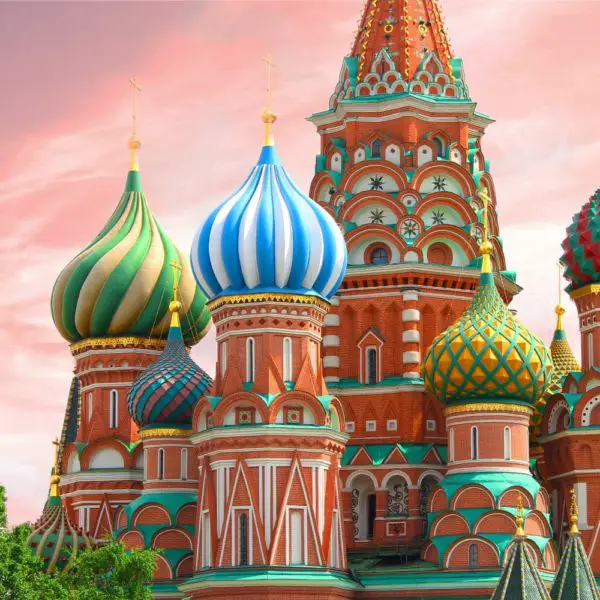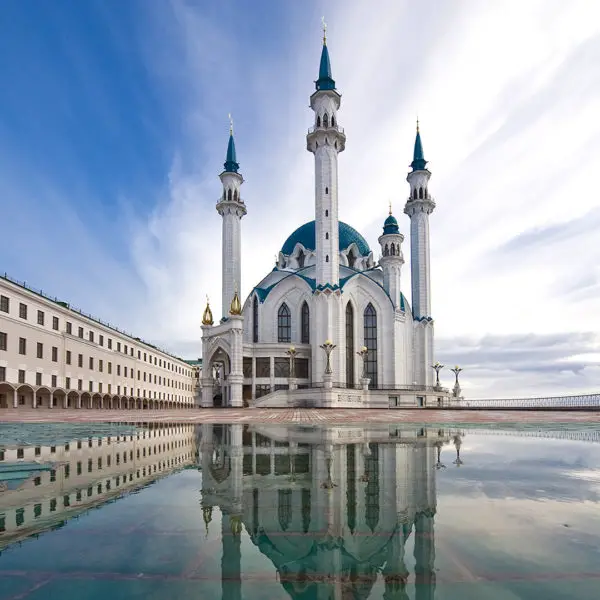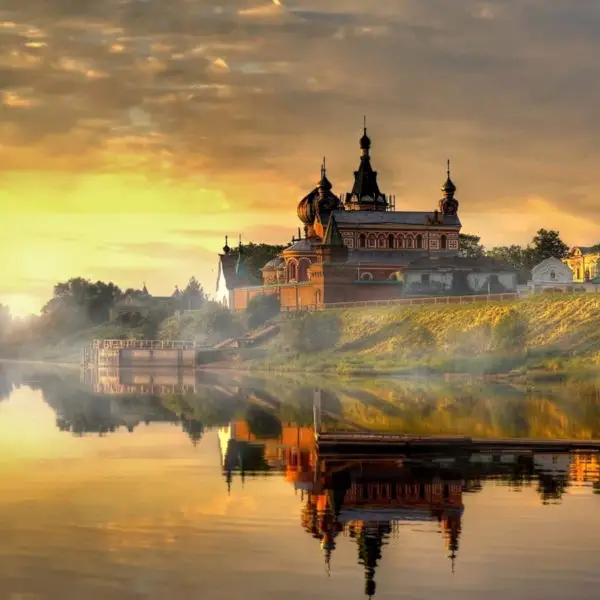Karelia Travel Guide - Russia's Most Inspiring Region
For those planning a trip to Russia and wanting an experience that goes beyond the walls of Moscow‘s metropolitan kingdom and St. Petersburg‘s splendid palaces, consider extending your holiday to Karelia!
With the help of this Karelia Travel Guide, you won’t have to travel as far as Siberia to be surrounded by the authentic taiga. One night by train and you will find yourself in a land of white nights, boundless forests and crystal-clear lakes.
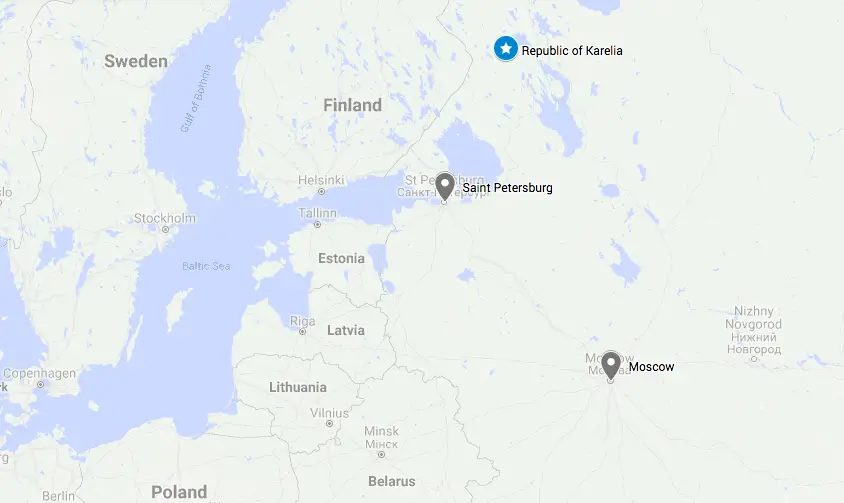
Bordered by Finland to the west and the White Sea to the east, Karelia is rapidly becoming one of Russia’s top destinations for travellers all around the world to visit. With a fantastic mix of untouched nature, outdoor adventure and cultural discovery, every traveller can (and will) find a reason to fall in love with this near-magical frontier country.
Our Karelia Travel Guide will take you through everything you need to know about this spectacular Northwestern region of Russia. Whether you’re searching for the best time of the year to visit, the top attractions or how to travel to Karelia, we have you covered.
Table of Contents
Who Should Travel to Karelia?
Karelia For Nature Lovers and Active Adventurers
Densely forested and gloriously remote, Karelia is a paradise on Earth for any nature lover. Be enthralled by the region’s untouched wilderness and diverse wildlife, from picturesque hills and winding rivers to lush green forests and idyllic lakes, such as Europe’s two largest lakes – Lake Ladoga and Lake Onega.
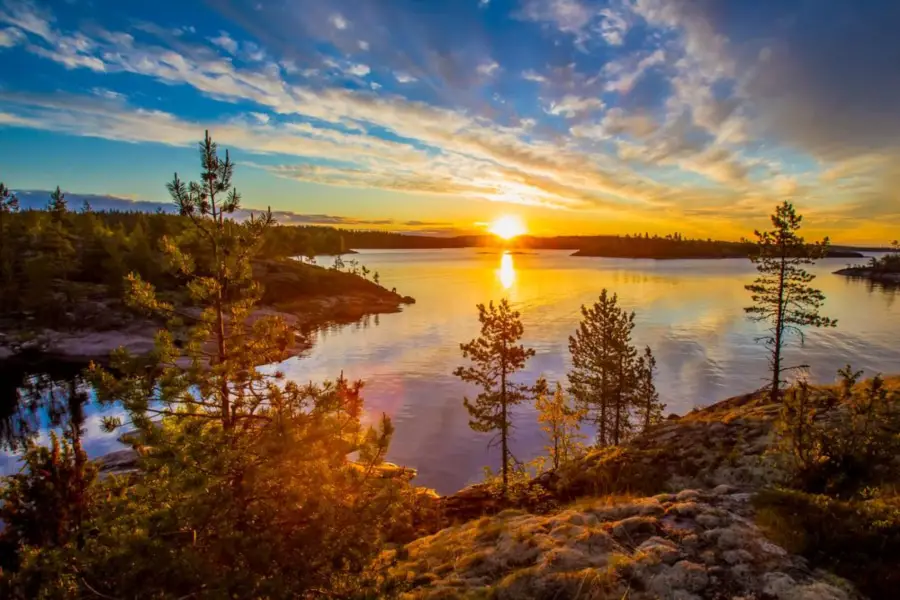
For those seeking an exciting and action-packed holiday, Karelia has a wide range of summer and winter activities to get the blood pumping. Water tourism is highly sought after during the summer months. Navigate your way around the region’s vast waterways on a canoe, kayak across crystal-clear lakes, go on a whitewater rafting adventure or try your hand at fly fishing.
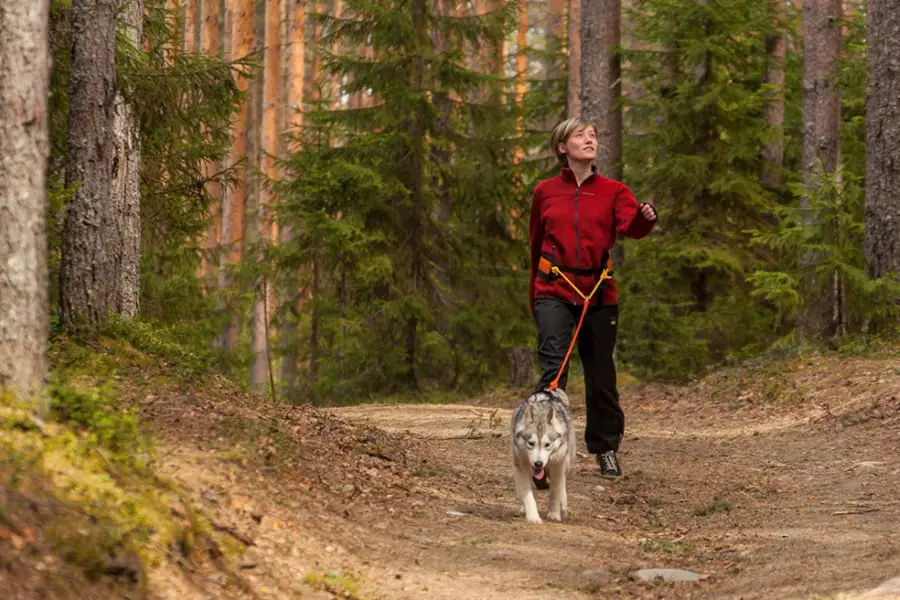
The landscape is also threaded by hiking routes, and its forest roads are ideal for bicycle or quad bike tours during this time of the year. In winter, you will have the opportunity to engage in all types of skiing, embark on a dog or reindeer sledding adventure or speed across the lands on a snowmobile. Other outdoor pursuits include snowshoeing, ice fishing and sledding.
Karelia For History and Culture Buffs
While a large portion of Karelia’s appeal is its untouched wilderness, it is by no means a simple no-mans land. Instead, Karelia can be considered a living museum of human history. Inhabited by the Scandinavians for 6,000 years, Karelia has been intermittently contested by the Finnish, Swedish, and Russian forces over the centuries. Today, despite having much of its territory ceded to the Soviet Union in 1939, the region still retains a strong cultural connection with eastern Finland.
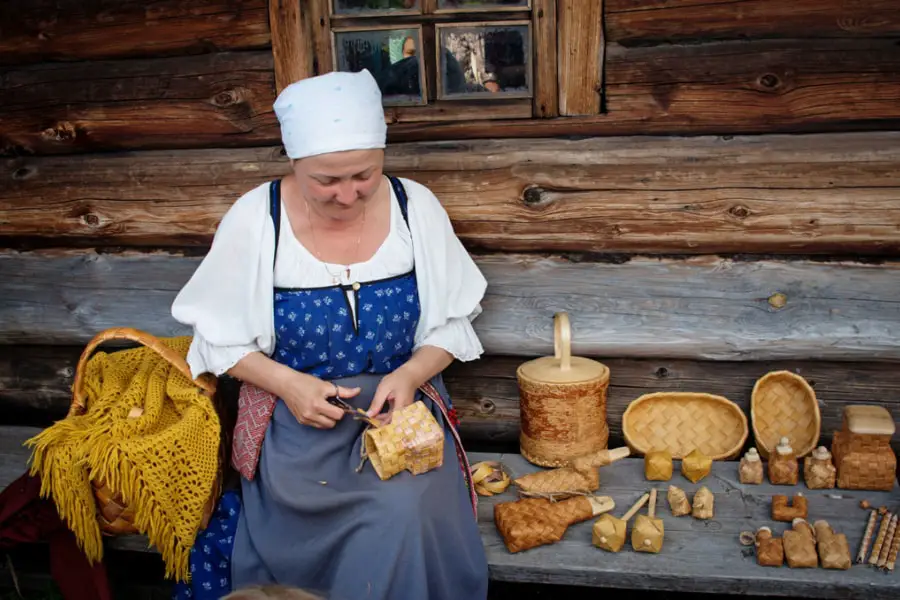
Those interested in history and archaeology can discover some of the most complex and expressive prehistoric stone carvings on the shores of the White Sea and Lake Onega, which also keep the secrets of the ancient Sami’s labyrinths on the islands.
Karelia For Architecture Enthusiasts
Karelia houses some of the best-preserved traditional wooden architecture in the country. The intricate beauty and unique architectural framework specific to Northern Russia would make even the most experienced traveller stand in awe.
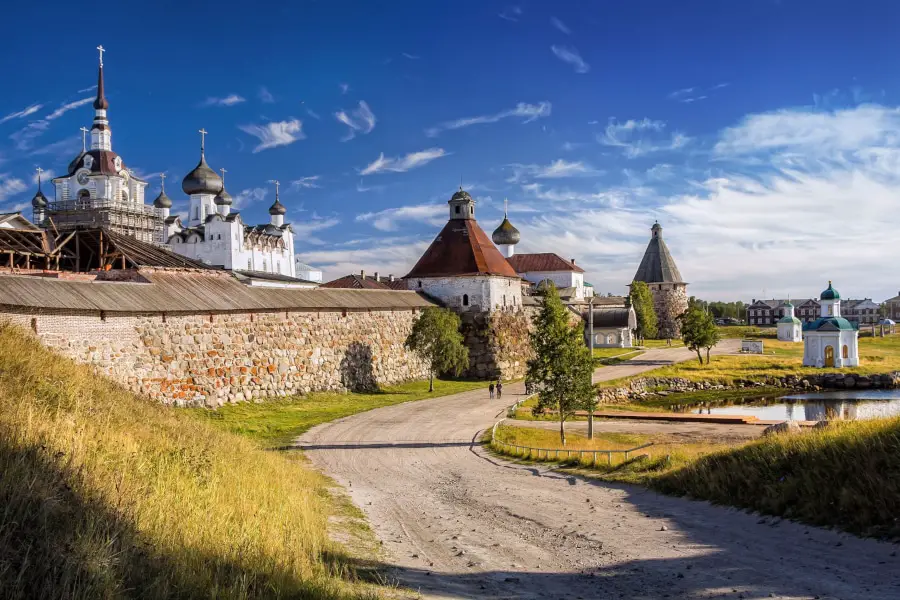
From ancient villages and banyas to collections of 17th and 18th-century churches skillfully crafted entirely out of wood, anyone with even the slightest bit of appreciation for architecture must visit Karelia at least once in their lifetime. Noteworthy architectural jewels include the Church of Transfiguration and the Assumption Cathedral on Kizhi Island.
Karelia Travel Attractions
Karelia Travel Destination #1: Petrozavodsk
Petrozavodsk is the capital and the largest city of the Karelia, stretching along the western shore of Lake Odega for around 27km. While travellers mainly use Petrozavodsk as a launching point for Karelia’s main attractions (Kizhi, Solovki and Valaam Islands), it has so much more to offer.
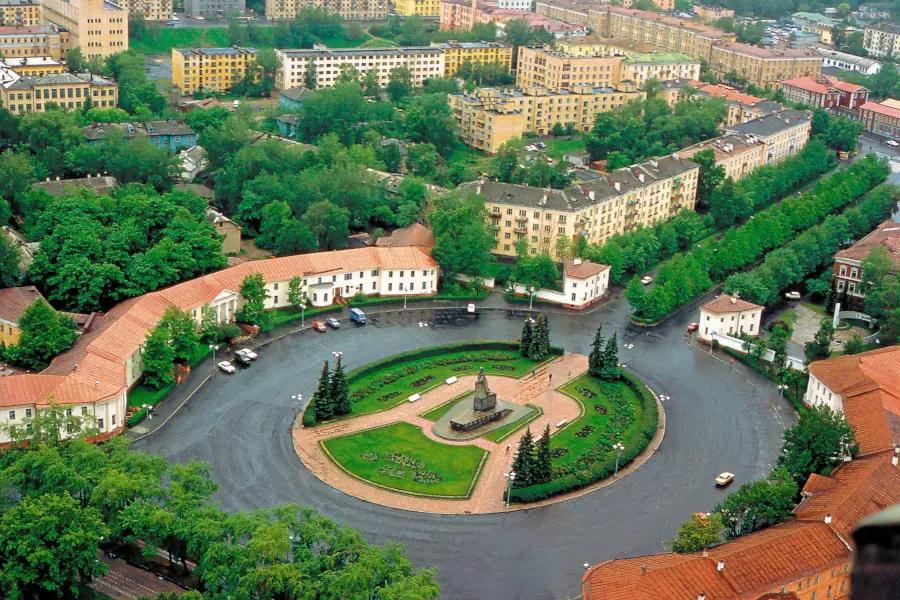
Multifaceted and diverse, this modern city draws in tourists with its neoclassical architecture and evolving cultural sphere. Noteworthy museums include the “House of the Doll” Tatyana Kalinina, the house-museum “Karelian Hut”, the Karelian State Museum of Local Lore, and the Museum of Fine Arts of the Republic of Karelia. Those interested in theatre should also visit the Musical Theatre of the Republic of Karelia, admire its gorgeous architecture and take a stroll through its surrounding square and park. Petrozavodsk is unique in nature due to its location, as it has a blend of Russian, Karelian and Finnish culture. This is expressed through the local cuisine, language and everyday lifestyle. Furthermore, being the capital of Karelia means that it is a local hub for nightlife and shopping, with several new shopping centres popping up around the city over recent years. Petrozavodsk also hosts several festivals, such as the International Contest of Snow and Ice Sculptures “Hyperborea”, Vozdukh live music festival, “White Nights of Karelia” music festival, and the landscape festival “Harmony of White Nights”.
Karelia Travel Destination #2: Kizhi Island
Located on the northern end of Lake Onega, the tiny island of Kizhi is home to one of the largest open-air museums in the world. The museum is a spectacular cultural site comprised of over 80 monuments of wooden architecture collected from the 17th to the 19th centuries and skillfully crafted and restored to form a glimpse of the past. Old chapels, peasant houses, windmills, threshing barns and granaries can be found scattered all around the island.
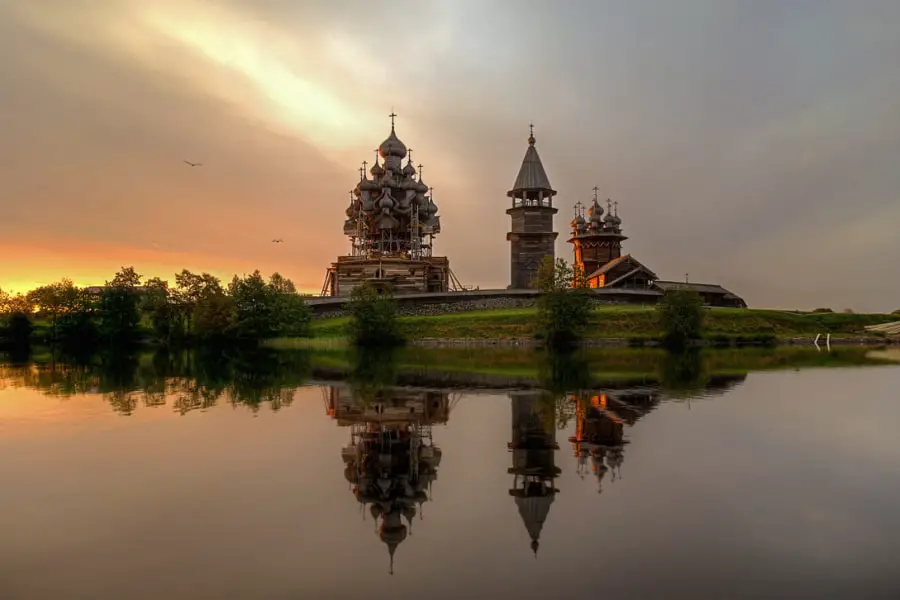
The crown jewel of Kizhi is the Church of Transfiguration, otherwise known as Preobrazhenskaya. This architectural masterpiece features 5 tiers of 22 wooden domes, gables and ingenious decorations designed to prevent rain from ruining the walls. Built-in 1714 without the use of a single nail, it has withstood the elements for over 150 years. The Kizhi Pogost, which is a fenced area including the Church of Transfiguration, Church of the Intercession of Holy Mary (9 domed church) and the Bell-Tower, has been included in the UNESCO World Heritage List as the most prominent monument of ancient northern wooden architecture. Other must-see attractions include the 14th century Church of Ressurection of Lazarus and the Chapels of Archangel Mikhail.
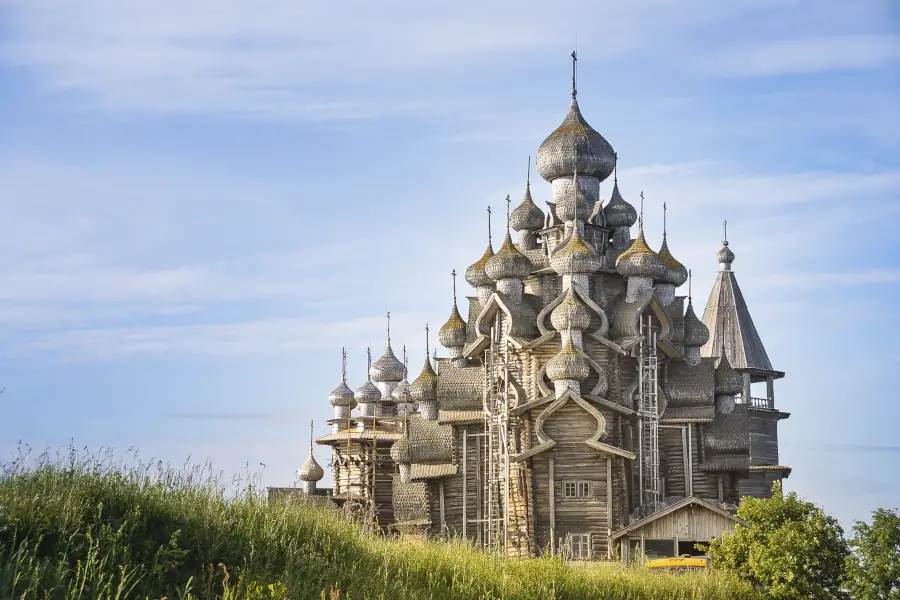
With local villagers and artisans still living on the island to this day, they demonstrate rural life in Karelia, its traditional crafts from the 18th and 19th century, such as weaving, woodcarving, and painting, and tasks of peasant life. Rent a bicycle and explore the stunning landscapes and impressive architecture that Kizhi Island has to offer, or join a tour for an insight into the gradual development of a unique Karelian culture that differs greatly from the rest of Russia.
Karelia Travel Destination #3: Valaam Island
Valaam, dubbed the ‘Russian Vatican’, is an archipelago located in the northern region of Lake Ladoga. As one of the most popular Orthodox tourist destinations, the main attraction that draws visitors to its shores is the 14th century Transfiguration Monastery on Valaam Island.
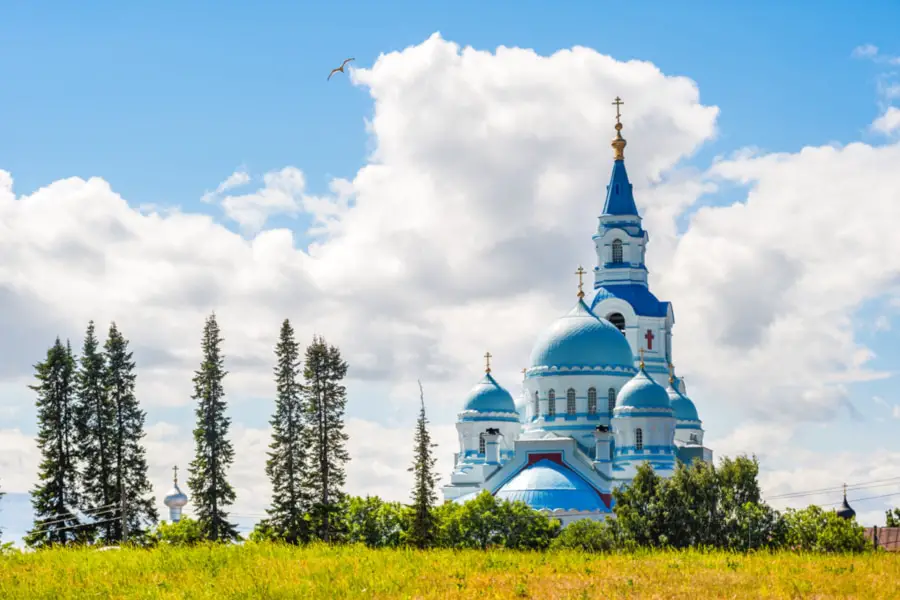
The central monastery is a monumental structure that sits on top of the high hill, making it visible from many locations on the island. In the past, the monastery had been subjected to numerous accounts of destruction and devastation from fires and invasions. However, despite that, it was revived to live again. Now, nestled in its central part are gardens, a bakery, vegetable patches and a farm, surrounded by pine trees, rolling prairies and granite cliffs with around 200 Orthodox monks living within its walls permanently.
If you are looking to avoid crowds of travellers, you can also explore dozens of other smaller churches and chapels that are scattered around pretty headlands, quiet inland bays or bridged islets.
Karelia Travel Destination #4: Solovetsky Islands
The Solovetsky Islands, otherwise known as Solovki, is a place that many travellers fantasise about visiting when in Russia but few actually ever end up doing so. This is part of the attraction, however, as it means that you won’t encounter hoards of tourists in this largely unspoiled part of Russia, yet you can have an ‘off the beaten track’ experience without having to rough it up too much. Located in the Onega Bay of the White Sea, the archipelago is made up of 6 main islands and many smaller ones. The largest island is the Bolshoy Solovetsky and it is home to the main monastery, which dominates the rural idyll of Solovetsky Village, the islands’ main settlement.
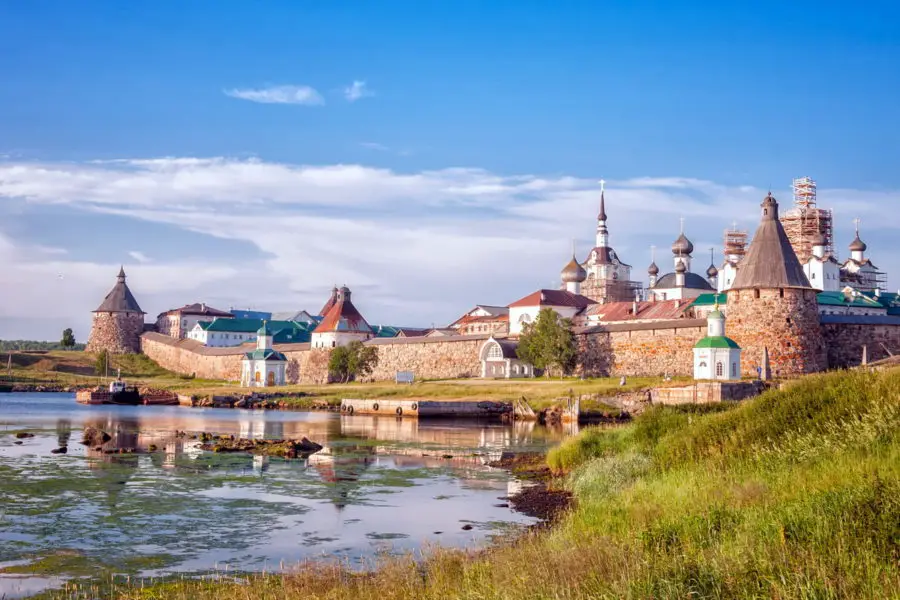
Listed as a UNESCO World Heritage Site, the Solovetsky Monastery is a real stronghold for orthodox Christianity and for a while, Solovki was seen to symbolise nothing but asceticism, faith and spirituality. This took a drastic change in the 20th century as Stalin transformed it into one of the USSR’s most notorious prison camps.
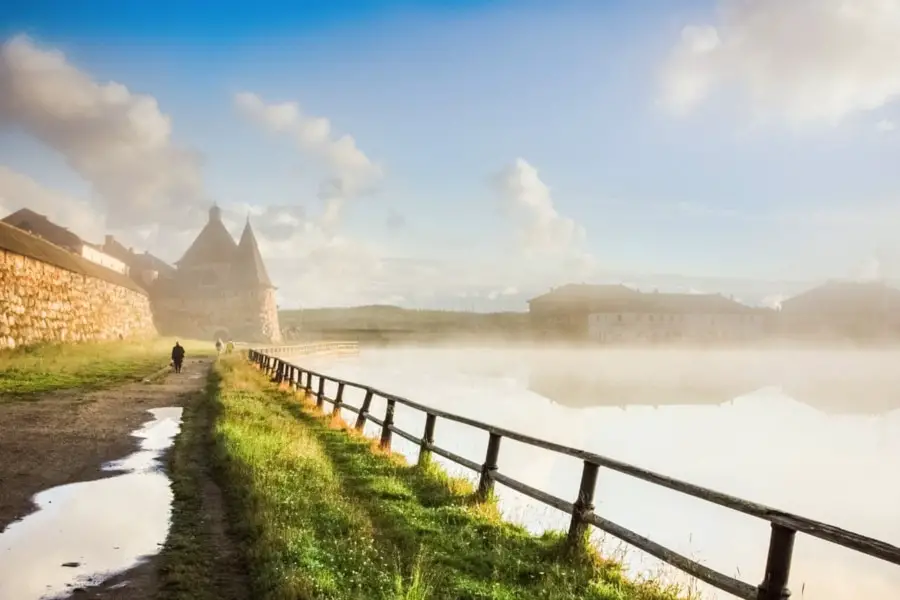
Even if you’re not a history buff, the island’s main museum is worth a visit as it is dedicated to those who were incarcerated here during the Stalinist era. There’s no English translation but the photos, pictures and artifacts more than speak for themselves. The monastery was rehabilitated after the fall of the Soviet Union, and today the islands’ natural beauty, spiritual significance and solemn history draw travellers from all corners of the Earth to its shores.
Karelia Travel Destination #5: Kinerma – Village
The historical village of Kinerma, situated 100 km from Petrozavodsk, is a unique complex of wooden architecture specific to the Karelian-Livviki and a living example of the traditional settlements in Karelia. Said to be the most beautiful village in Russia, no new houses are allowed to be built on the lands. Everything seen today has been erected and restored according to the ancient plan of the village.
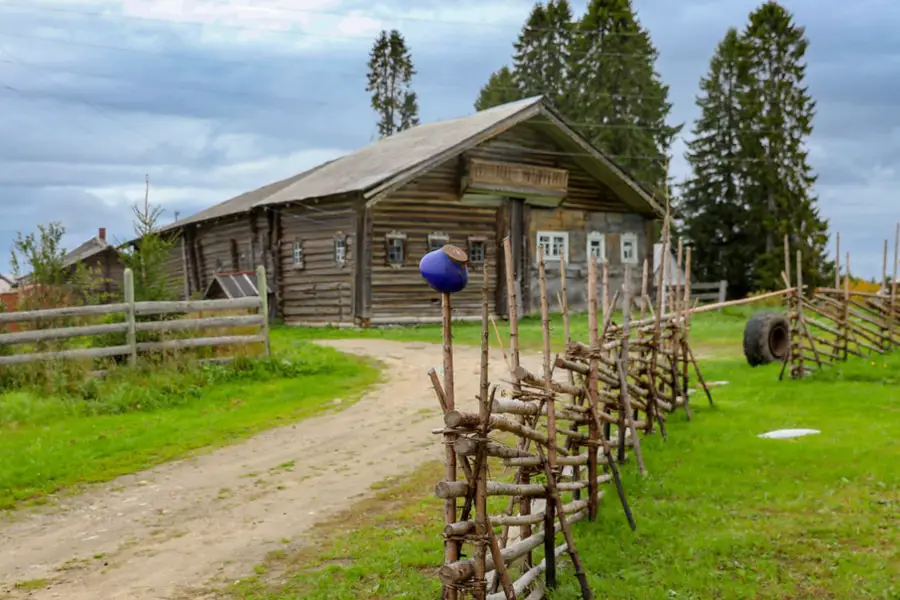
Currently, in the village of Kinerma there are 16 yards and only 5 permanent residents, but they are actively farming, preserving and maintaining the traditional rural way and visitors can visit the village personally to touch the past. With 17 houses, 7 baths, and an old cemetery, the main attraction and spiritual centre of Kinerma is its chapel, built in the second half of the 18th century in honour of the icon of Virgin Mary from Smolensk. According to legend, the icon was brought to the village by a passing soldier and has since protected the village from any harm and misfortune.
Another noteworthy attraction is the black banyas, typical of Karelian villages. Such banyas are built without a chimney and use the smoke from its primitive stoves made of stones to warm the sauna. We would highly recommend experiencing a session in a black banya, as the temperature inside is not too high, but the humidity is high enough to free yourself from all toxins and stress.
Karelia Travel Destination #6: Ruskeala Mountain Park, Sortavala
For lovers of active leisure, Ruskeala Mountain Park is the place to be. Formerly a marble quarry, this 109-metre wide canyon is a unique and multidimensional monument to both nature and the history of mining. Mined by the Karelians, Swedes, Finns and Russians for nearly three centuries, the marble has been used in the construction of some of the most significant structures in Russia, such as the floors of the Kazan Cathedral, St. Issac’s Cathedral and the window sills of the Hermitage in St. Petersburg.
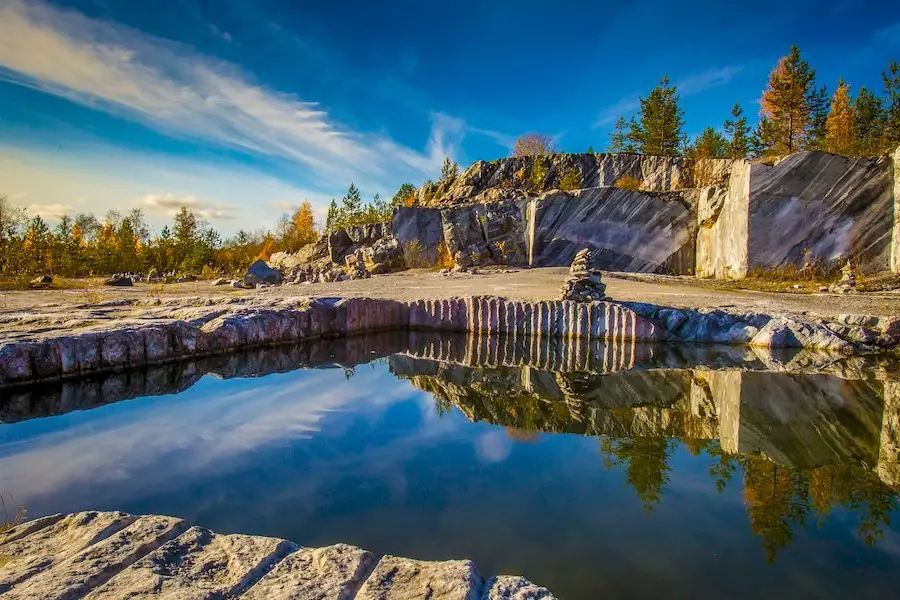
Now, tall pines line the top of the steep canyon walls while its sides are riddled with caves and grottoes just waiting to be explored.
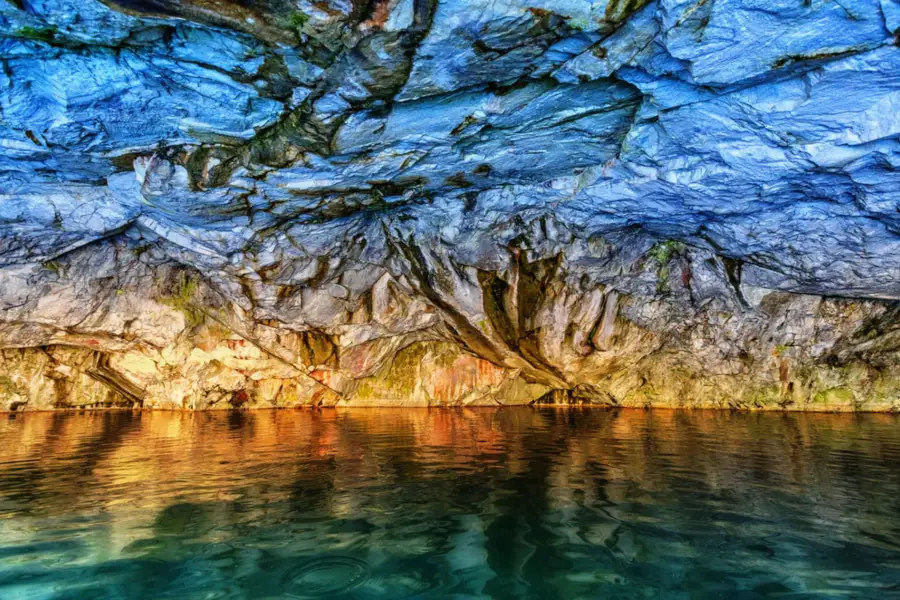
Over the years, the canyon has also filled up with the purest emerald-green water from underground springs. Karelia travellers can navigate through its system of open and underwater galleries, drifts and shafts, all of which stretch a total of several hundred metres.
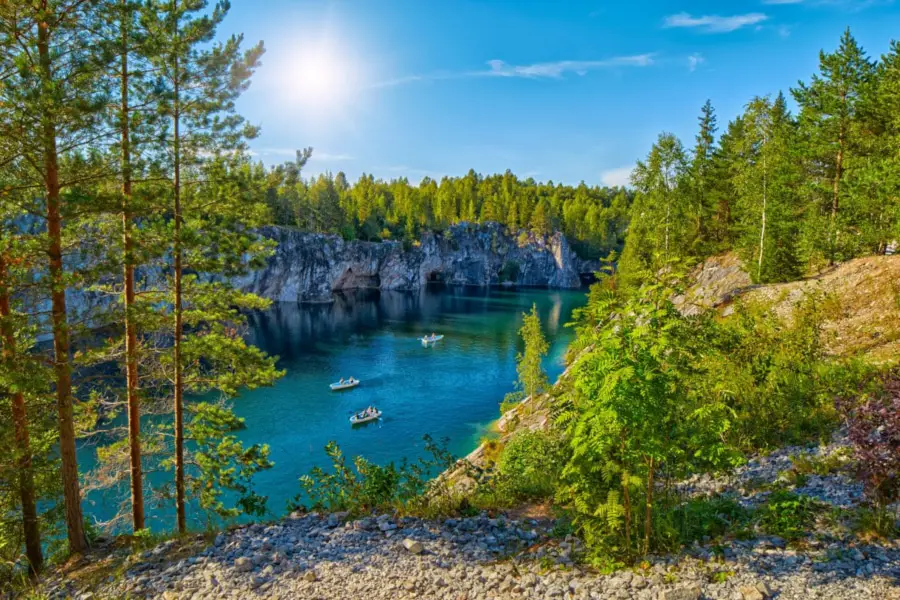
Apart from hiking along some of the most breathtaking tracks, you will also have the opportunity to ride trolleys (mechanized bungees) over its waters, rent a boat and explore the beauty of Marble Lake, go down into abandoned mine shafts and ice-skate over the icy bottom of its caves. It is also only in Ruskeala that you will be able to find preserved exotic mosses, lichens, orchid plants and shrubs, as well as rare species of reptiles, amphibians and even bats.
Karelia Travel Destination #7: Ruskeala Express Retro Steam Train
The Ruskeala Express provides an incredibly scenic journey through the forested landscapes of Karelia to one of the most beautiful natural preserves in Russia, Ruskeala Mountain Park.
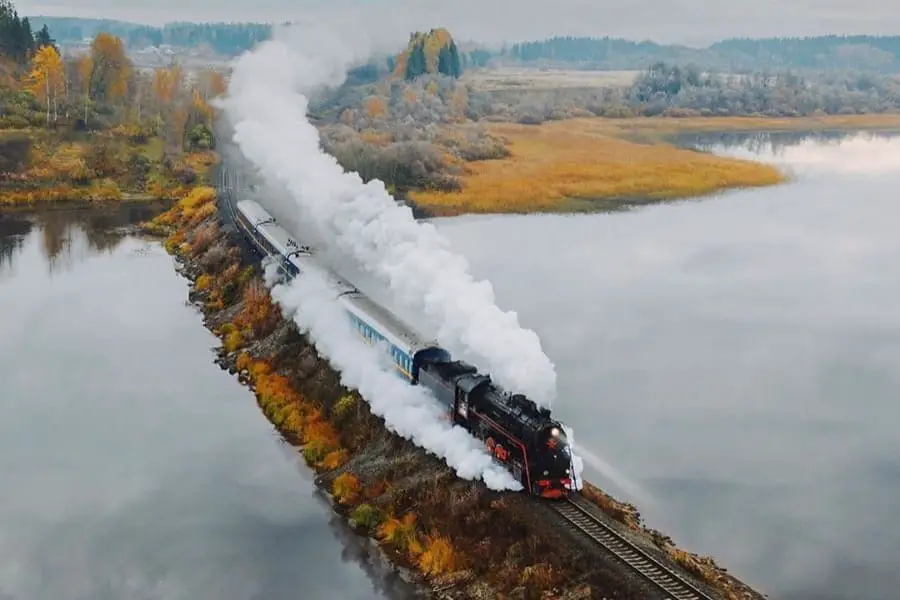
The retro-style steam train runs daily between Sortavala (250km west of the Karelian capital, Petrozavodsk) and takes around an hour to reach the park entrance. The Ruskeala Express is the only daily steam-powered passenger train left in Russia. Running on a locomotive engine built in 1949, its interiors are inspired by the late 19th century look. Between July and September, non-stop train services run between Moscow and Sortavala, with a total travel time of 17.5 hours.
Karelia Travel Destination #8: State National Park Paanajärvi
In contrast to the action-packed Ruskeala, Paanajärvi National Park is all about reconnecting with nature and finding your own zen away from civilization. Located in the north-west region of Karelia, the main purpose of establishing the Park was to preserve the unique nature of the Olanga River and Lake Paanajärvi.
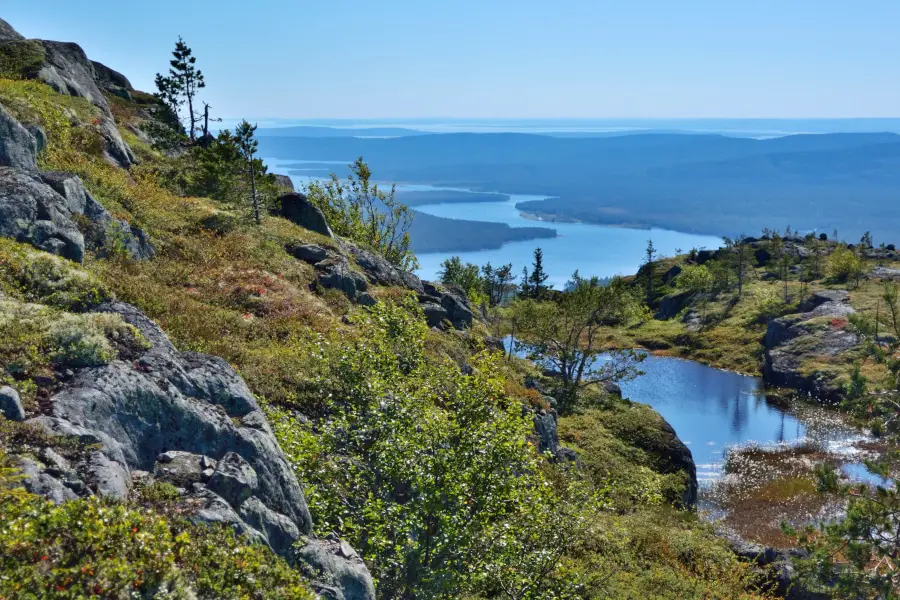
The landscapes are exceptionally breathtaking; mountain ridges are split by deep ravines, fast-flowing streams with frothing rapids cut through the terrain, and crystal-clear lakes sparkle under the sun’s gentle rays. Its valleys and hills alike are covered with virgin forests, where giant pines and spruce dominate the lands.
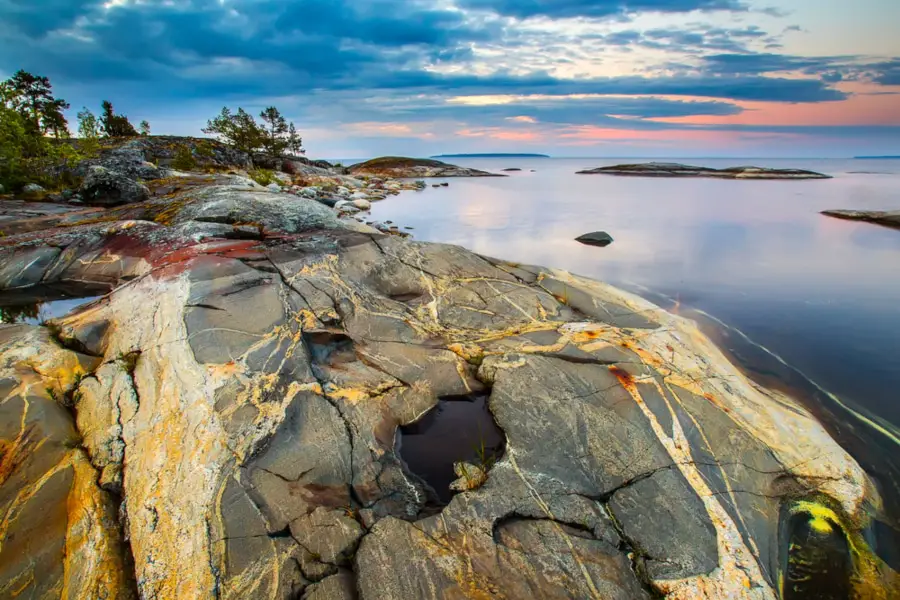
You can also find numerous fauna roaming around freely, such as bears, elk, wolverines, foxes, and reindeer. On a rare occasion, you may even be able to spot muskrats or beavers. The pearl of the park is Lake Paanajärvi – the biggest lake in the region. It is situated in a large bedrock rift and extends for about 15 kilometres from the East to West.
In winter it’s one of the most popular places for Northern Lights hunt.
Karelia Travel Destination #9: Petroglyphs of the White Sea and Lake Onega
Created during the Neolithic era, the petroglyphs of Lake Onega and the White sea are considered as some of the most complex and expressive samples of Late Stone Age art in northern Europe. The drawings depict elaborate scenes of warfare, seafaring, hunting, religious rituals, skiing and enigmatic figures. With more than 70 different ancient settlements identified in relation to the carvings, they constitute the largest Neolithic site in the region.
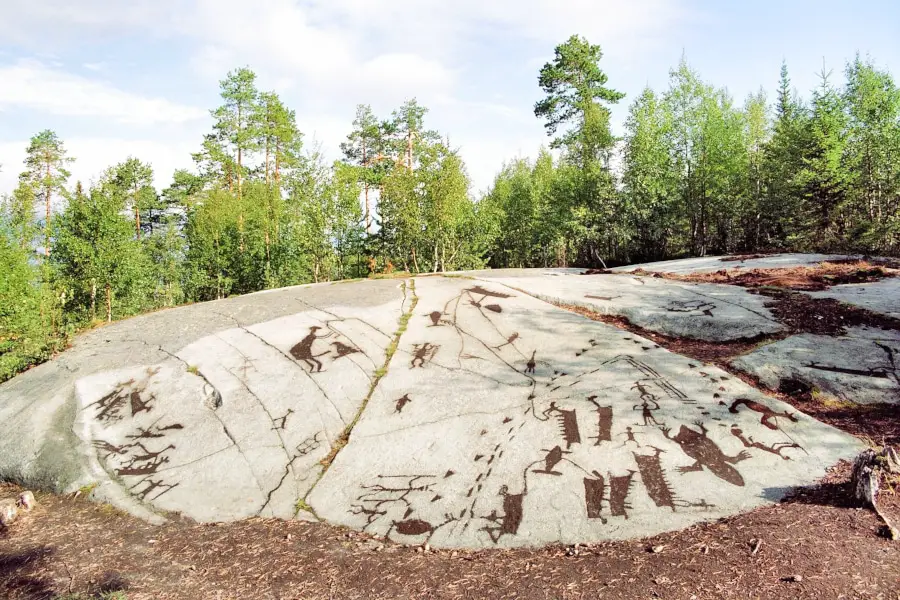
The Onega petroglyphs are located along the eastern shore of Lake Onega for a distance of about 18.5km, while petroglyphs of the White Sea are found about 6 to 8km from Belomorsk. Carved into stunning locations such as on huge flat boulders on islets in the middle of untouched forests, these petroglyphs are easily accessible to study and photograph.
Karelia Travel Destination #10: Vottovaara Mountain
A 417m glacial mountain peak and archaeological site in the West Karelian Hills, Mount Vottovaara is known for its bizarre, boulder-strewn landscape. Surrounding the peak is a patchwork of strange “legged” stones, oddly deformed trees and miniature lakes.
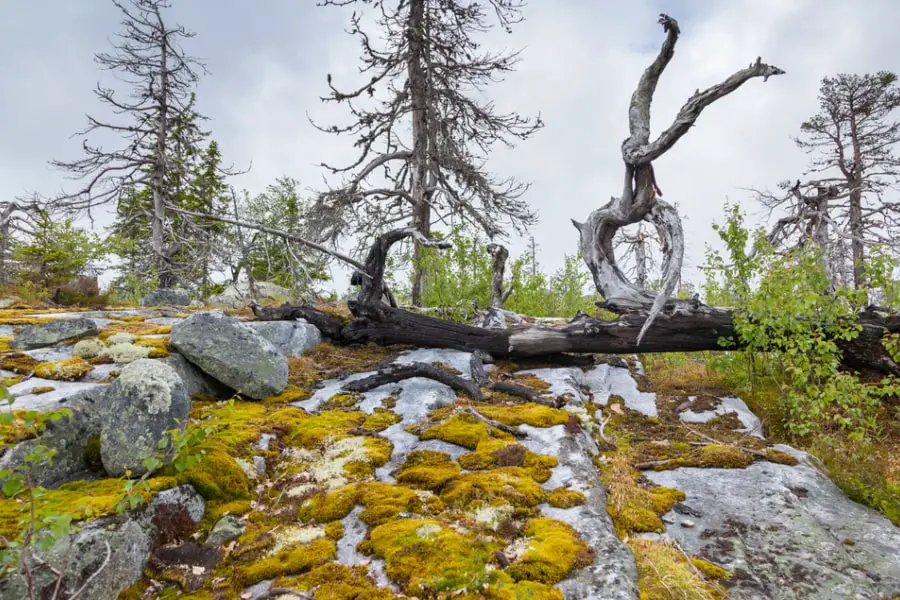
A superb hiking destination in Karelia, Mount Vottovaara is considered sacred among the Sami people, who historically inhabited all of Northern Scandinavia as well as Eastern Karelia.
Fantastic rock paintings discovered here and in nearby Lake Onega (known as the Onega petroglyphs) suggest that this was an ancient pagan ritual site as far back as an estimated 6,000 years ago.
Karelia Travel Destination #11: Karjala Park
In a picturesque rural location on the banks of the Shuya River, Karjala Park is a Scandinavian-style eco-hotel and year-round outdoor recreation complex with a wide array of activities on offer for day visitors and hotel guests.
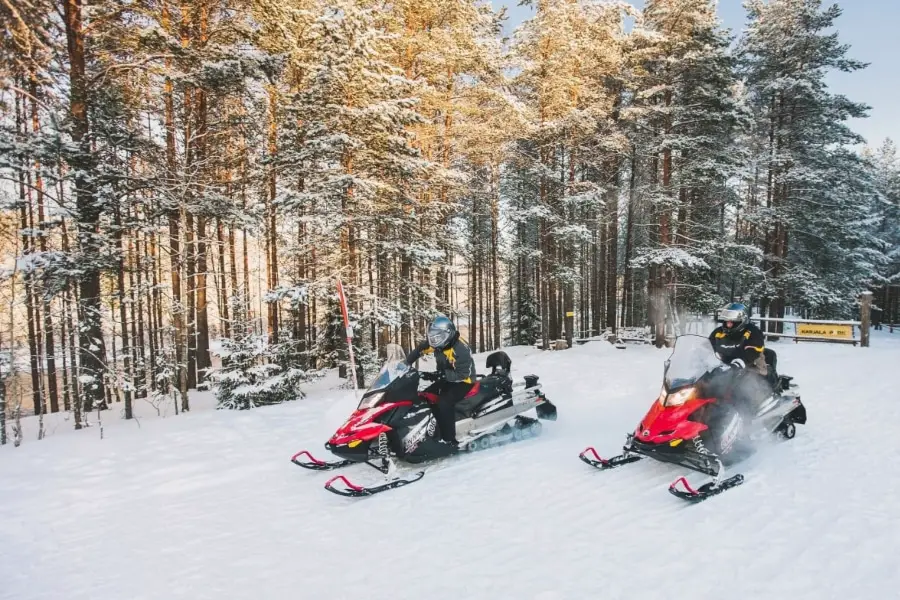
During winter, the beautiful forested setting of Karjala Park provides an adventure sports playground with activities like husky dog sledding, snowmobiling and ice fishing. Summer activities include trekking, rafting and kayaking on the Shuya River. ATV and 4WD tours, fishing and authentic Russian and Karelian cooking classes can be enjoyed all year round.
Karelian Culture, Festivals & Cuisine
Sharing a 700km long border with Finland to the west, the Republic of Karelia is traditionally the home of the Karelians, a Baltic-Finnic ethnic group who today make up just over 34% of the population of Russian Karelia. Karelian, Finnish and Veps (another minority Finnic group residing on the Russian-Finnish border) are officially recognised languages in the Republic.
Today, Karelia retains a strong cultural connection with Finland. Distinctly Karelian culture lives on in the peasant traditions of poetry, music and folk ceremonies that reinforce the people’s bond with the land and sea.
Karelian traditions and folklore
Scandinavian sagas and chronicles tell us that the Karelians were known to the Vikings as early as the 7th century AD. Karelian traditions and celebratory rites are closely related to a work of epic poetry compiled from Karelian and Finnish oral folklore and mythology. The Kaleva deciphers the local runes and explains the origins of the region and its inhabitants. It tells the story of the hero and demigod Vainamoinen, who according to legend built the first boat and created Karelia’s national musical instrument, the Kantele, a plucked string instrument somewhat similar to the dulcimer.
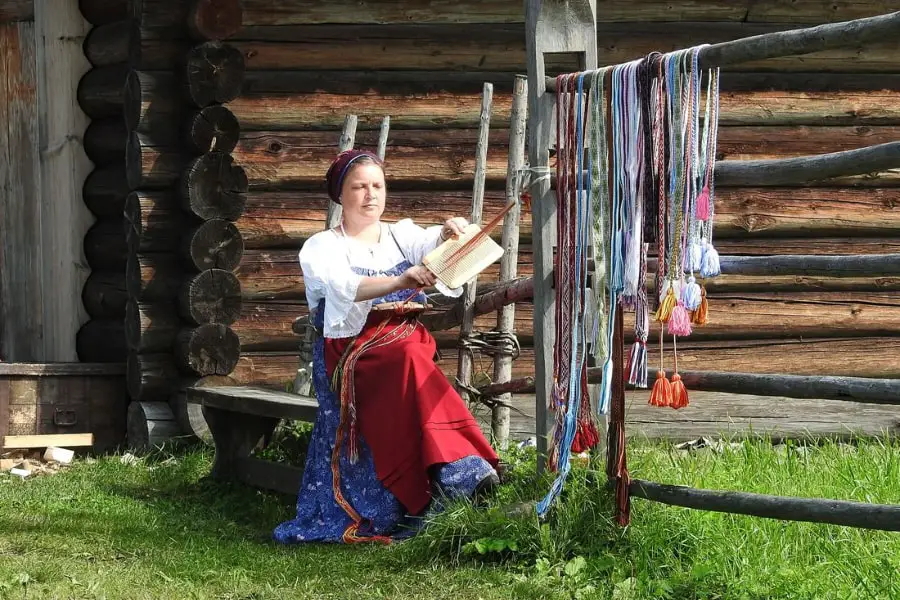
This legend and other pagan folktales inform many of the customs and festivals still practiced by the Karelian people today, although these days the majority of Russian Karelians are Eastern Orthodox Christians.
Festivals in Karelia
Midsummer Day or the Summer Solstice is the most important holiday in the traditional calendar for all northern peoples. The longest day in summer falls on June 22. Across Karelia, celebrations begin in the evening and last all through the night, during the time of the Karelian “white nights”, when sun lights up the land 24 hours a day. Young people would traditionally go to the forest to gather ferns, dance around bonfires and swim in the lakes.
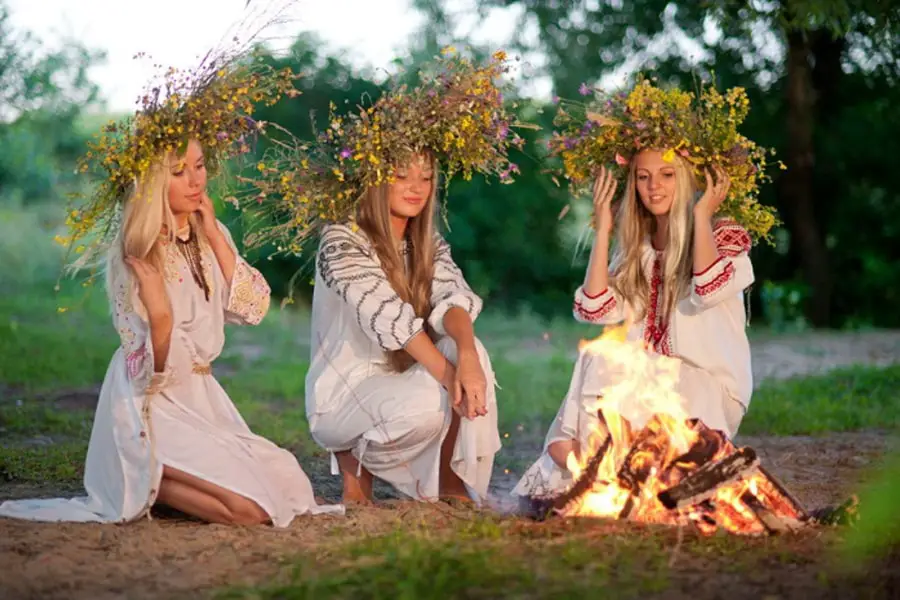
The White Nights of Karelia Music Festival is an annual event organised by the State Glazunov Conservatory in Petrozavodsk city. Held over several days and nights each summer, the festival program includes exclusive performances by local, Russian and international musicians, performing well-known masterpieces, chamber music and the latest orchestral works.
The Elonpu (Tree of Life) Festival is a pagan holiday for the Veps culture, celebrated in mid-July on the shores of Lake Onega near the village of Sheltozero. There are only an estimated 7,000 Vepsians left, and most of them live in Karelian villages.
Hyperborea, or the International Winter Festival is held annually in February in Petrozavodsk. The highlight of the week-long winter festival is the international competition of snow and ice sculptures. Professional and amateur teams from Russia, as well as guests from foreign nations compete to create the most impressive and elaborate sculptures, carved out of ice and illuminated by multi-coloured lights. The festival mixes high art and everyday entertainment common to the region, encompassing everything from art exhibitions and concerts through to ice swimming races and dog sledding competitions.
Karelian Cuisine
For the Russian food lovers out there, Karelian cuisine is nutritious and diverse. Karelia is famous for its baked dishes. A must-try appetizer dish of Karelia is Kalitki with potatoes. Served hot, it is an open pie made from rye flour dough with a filling usually made from millet kasha, potatoes, rice, tvorog or meat. Salted and marinated Karelian mushrooms are also very popular as a snack.
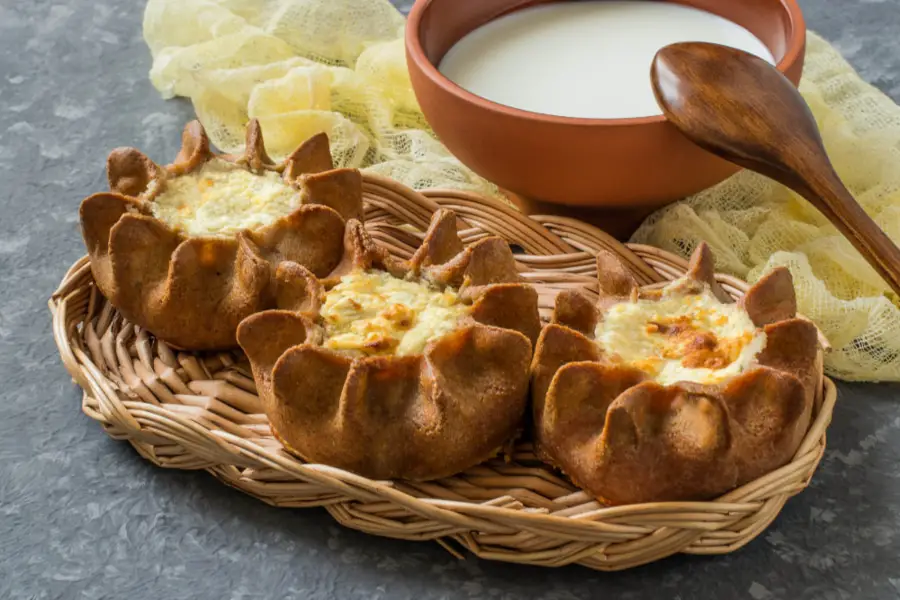
For the mains, local freshwater fish such as the delicious Northern salmon are often added into hearty fish soups or are marinated, salted and served as a separate dish. Remember to save room for dessert, as they make sweet northern pies, pastries and pancakes with delectable local wild berries. Finally, wash down the food with freshly squeezed berry juices or robust liquors made from cranberries, red bilberries and cloudberries.
Karelia Travel Tips – Weather in Karelia and When to Visit
Karelia’s climate is transitive from maritime to continental, and typically carries much milder winters in comparison to other northern regions near the Arctic. This is due to the warm, humid air masses from the west, though incursions of Arctic air can cause bitter cold spells. Karelia’s climate has therefore gained a reputation for being unpredictable, so no matter the season, Karelia travel guide readers should be prepared for practically any weather.
Summer in Karelia
June – August
Average temperatures: 11ºC to 21ºC
Summer in Karelia is the highest travel season. The reason is quite simple: the best way to see most of the attractions located in this beautiful region – by water. These include, in particular, famous Valaam and Kizhi – islands of the Ladoga and Onega lakes. The navigation season opens in mid-May and closes in mid-September. Therefore, if you want to go on a tour of the main attractions of Karelia, it is better to plan a trip for the summertime. For the most part, Karelian summers are short but the days are long and cool with a fair amount of rainfall scattered in between. Plenty of outdoor activities are available during this time, such as fishing, quad biking, kayaking, cycling and whitewater rafting.
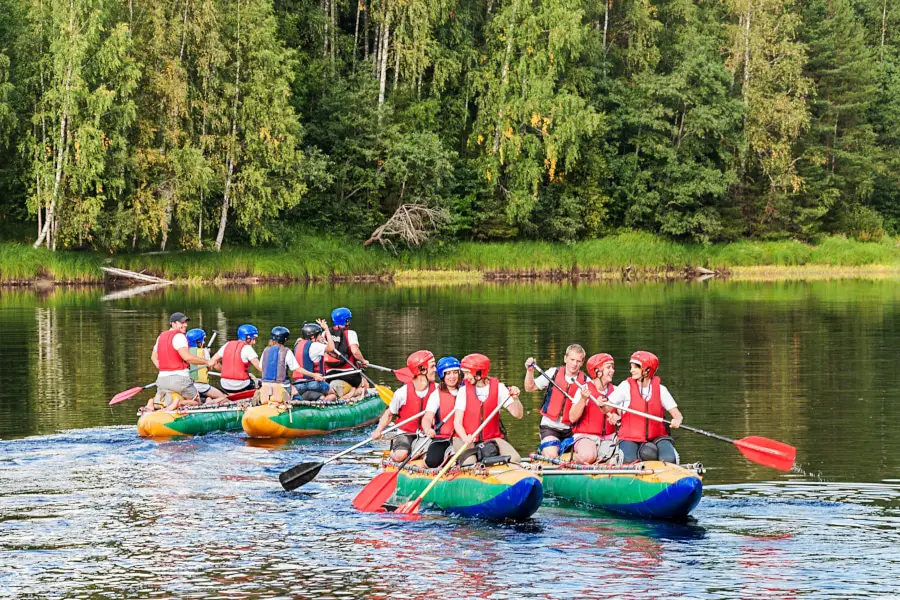
June (its end) is a month when you can experience the amazing spectacle of White Nights in Karelia, otherwise known as midsummer night or polar day. This is a time where the sun sets but remains above the horizon, bathing the landscape with a pearlescent all-night glow until the early mornings. Take advantage of this occasion and enjoy a night-time boat tour or a midnight stroll. This month is also the best for visiting the picturesque Marble Canyon at the mountain park “Ruskeala”, as well as visiting the “Kivach” Nature Reserve, which waterfalls are the fullest during this time.
The height of summer is during July, where you’ll be able to go for a swim in the many crystal-clear lakes scattered across the region. This summer month is very good for fishing: salmon, pike, roach, ide, steam perch, large bream are well caught in the local waters.
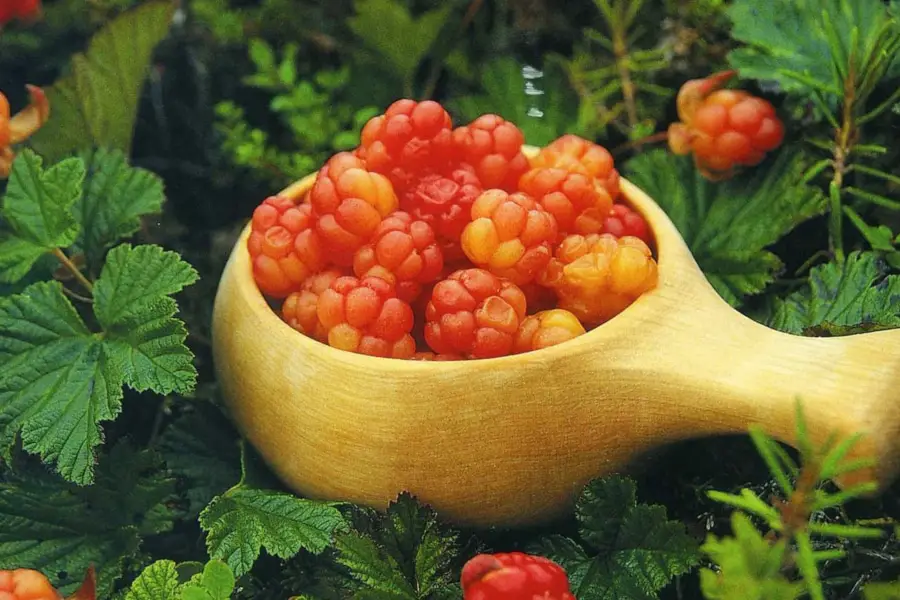
The summer heat often rolls over to August, but the nights start getting longer and cooler, it becoming rainy and foggy. August in Karelia is the time of picking berries. With the beginning of September, the high tourist season in this region of the Northern Russia ends and the off-season begins, which lasts until the beginning of December.
Autumn in Karelia
September – October
Average temperatures: -5ºC to +12ºC
The month of September is a lovely period as temperatures are still relatively warm, but you no longer have to worry about pesky mosquitoes. Lingonberries, cranberries and mushrooms are in full bloom, carpeting the forest and tundra. Trees start to turn yellow and gold, and the ground vegetation a deep red. This is what we like to call ‘Flaming Autumn’.
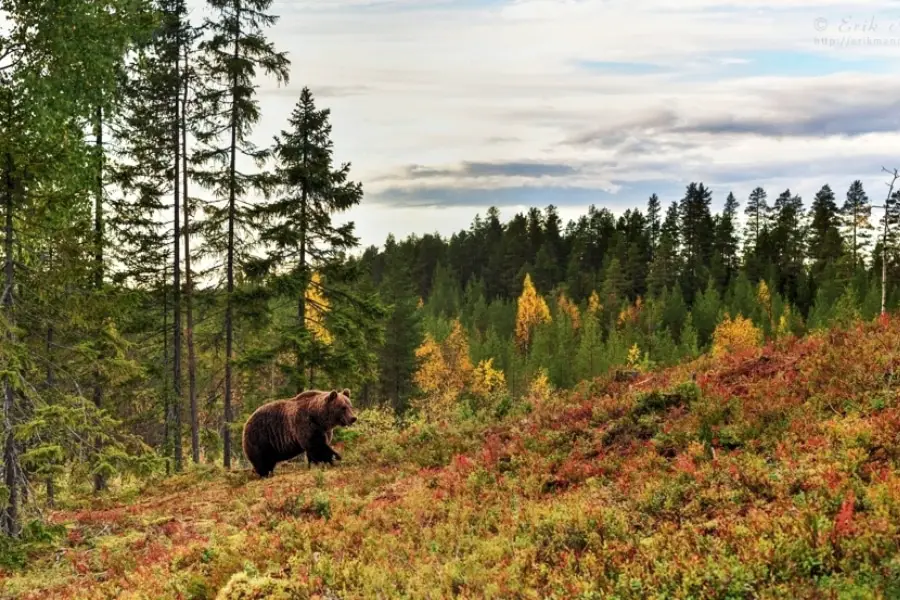
This is also one of the best time for photography. As temperatures start to cool in October, dip your toes in a steam bath and enjoy a hot beverage by the fireplace. This is when lakes begin freezing over and the snow starts to fall in preparation for a winter fairytale.
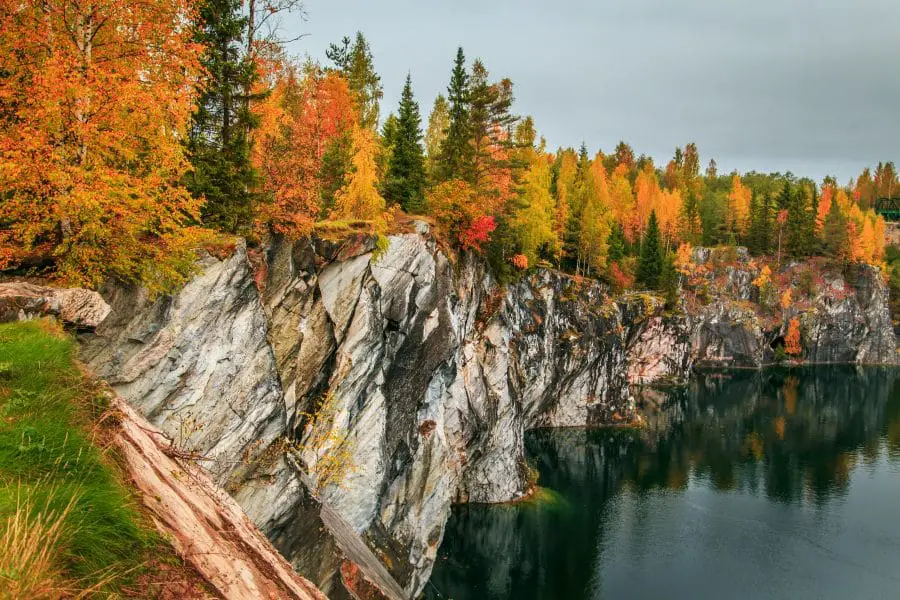
Winter in Karelia
November – April
Average temperatures: -15ºC to -5ºC
November is off-season with very unstable weather. Rivers and lakes are getting to freeze. It is still possible to get to such popular places as Kizhi or Valaam by hivuses and snowmobiles, but these sights are not as impressive as in summer.
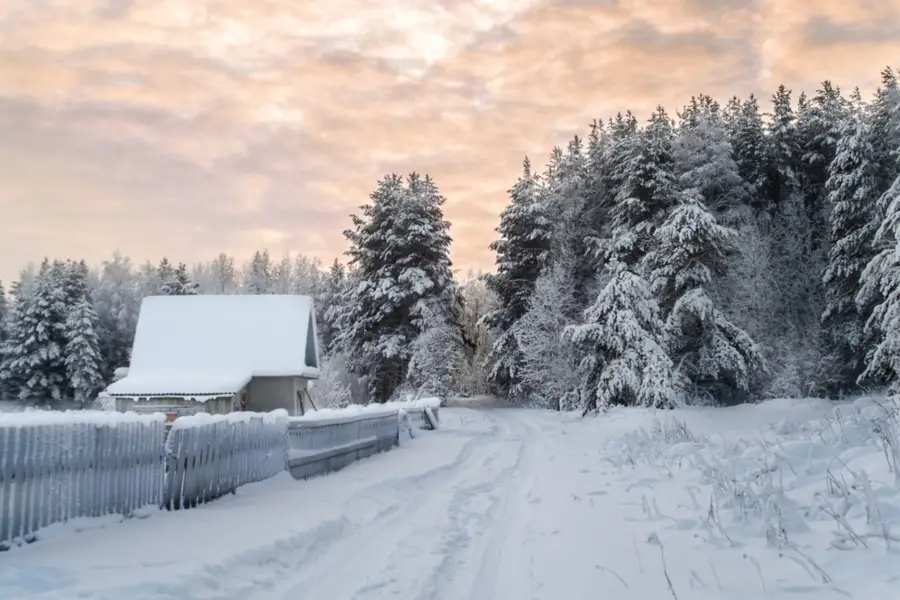
In December, snow covers the land and forests, turning the region into a winter wonderland. Explore the frosty ethereal taiga forests on a snowmobile or try your hand at dog-sledding with the famous Siberian huskies. Later on, settle down around a fire in a local dacha and soothe your muscles in a Russian-style sauna. Its proximity to the Arctic Circle means that the Karelian skies are sometimes graced by the stunning Northern Lights, which even can be observed in Petrozavodsk, although, the best place is somewhere far away from the city lights, such as the remote village of Nilmoguba or Paanajärvi National Park, located on the border with Finland. If you won’t get lucky with the Northen Lights hunt (it happens quite often), then at least you may admire the untouched nature of Northern Russia.

March is the sunniest month, while the very end of Winter – April, is the time when lakes and rivers start to get free from the ice.
Spring in Karelia
April- May
Average temperatures: 0ºC to +15ºC
Spring is arguably one of the best times to venture outdoors into the beautiful Karelian forests. Tree leaves turn green, flowers start to bloom, rivers flow faster. Try your hand at fishing in one of the many lakes and rivers, as early May is a time when Northern Pike and Perch spawn by the thousands.
Karelia Travel Options
Karelia Travel By Plane
At the moment, the only flights coming in and out of the Karelian capital of Petrozavodsk are from Moscow. S7 Airlines has flights that leave between 5 to 7 times a week from Domodedovo Airport, taking approximately 1 hour and 45 minutes. Be sure to keep an eye out on S7’s flight schedule as the timetable changes fairly frequently.
Once you arrive at the Petrozavodsk airport, it is about a 12km drive to the city centre. Pre-arranged private transfers are typically the preferred methods of transportation to get to town.
Karelia Travel By Train
This is the most reliable and convenient way of travelling to Karelia. There are several daytime and overnight trains running from the St. Petersburg Ladozhsky railway station to Petrozavodsk (approximately 7 hours). Usually, travellers prefer the overnight train, as it saves time and money.
Alternatively, trains from Moscow to Petrozavodsk run daily. The journey from Moscow to Petrozavodsk takes around 16 hours.
Karelia Travel By Bus
>Catching a bus is one of the cheapest ways to travel to Karelia. There are bus services running 4 to 5 times a day that travel between St. Petersburg and Petrozavodsk, with the journey taking between 5 to 6 hours.
Karelia Travel By Car
There are two main routes to Karelia: the M-8 and R-5 from Moscow via Vologda, and the M-18 from St. Petersburg (from Moscow you can get on the M-18 bypassing St. Petersburg through A114 Zuevo-Volkhov-Novaya Ladoga). If you were to choose any route other than the M-18, it should be noted that Karelian roads are in mostly bad conditions, quite bumpy and often include stretches of unpaved roads.
The approximate travel time from St. Petersburg to Petrozavodsk is 5 hours (430km), and 12 hours (996km) from Moscow to Petrozavodsk.
Related posts
Related Tours
If you have any urgent questions or enquiries, please give us a call +61 412 587 785
